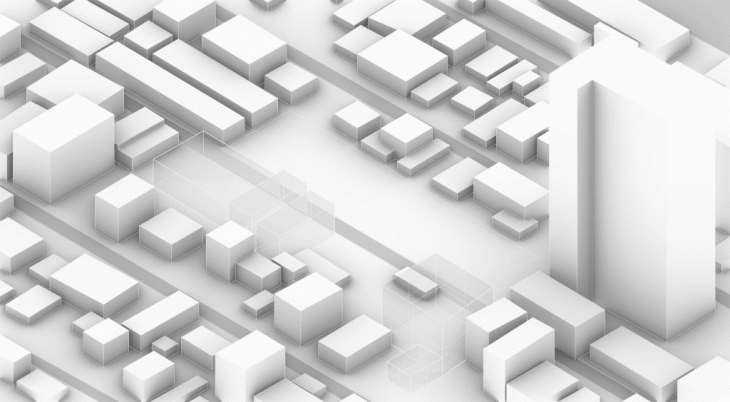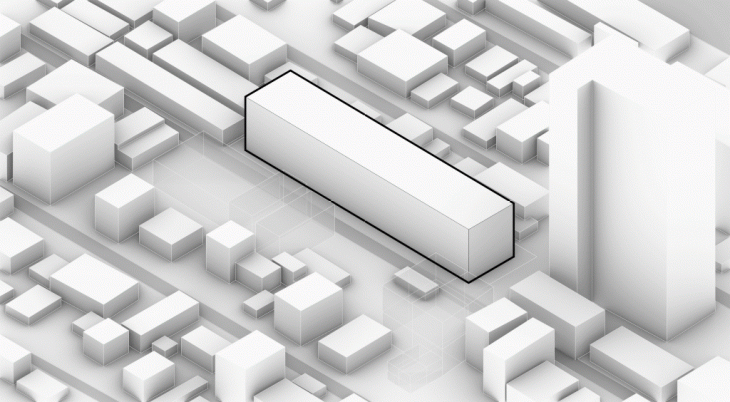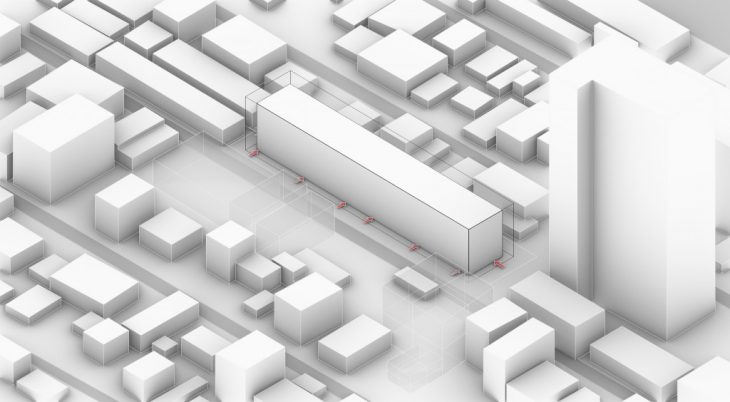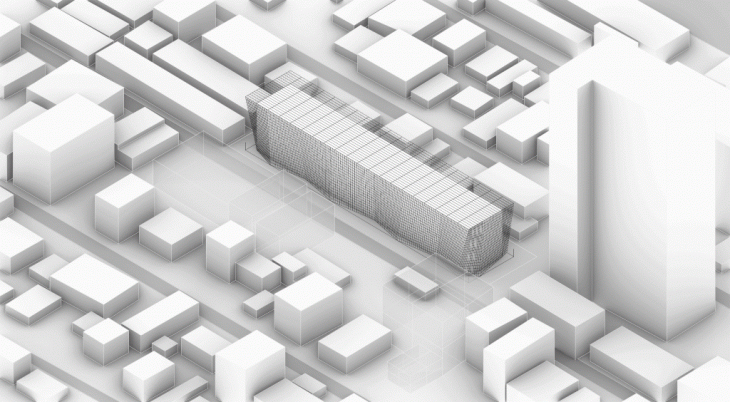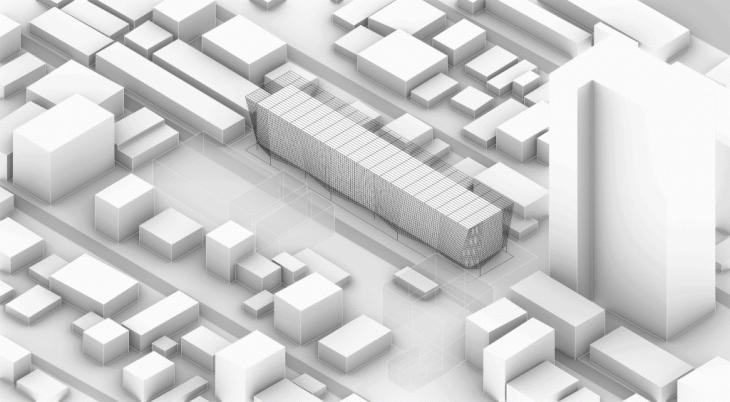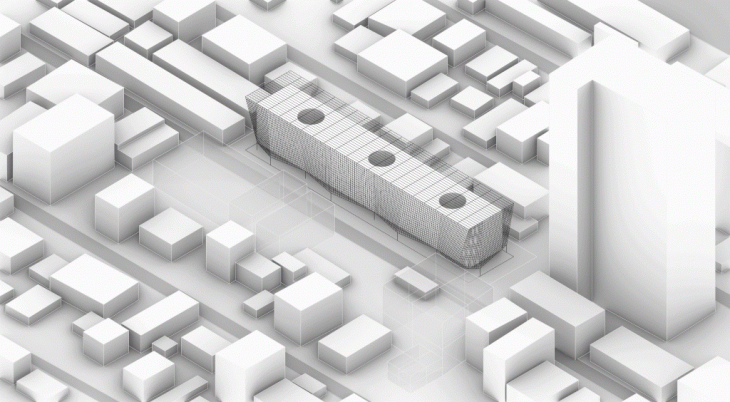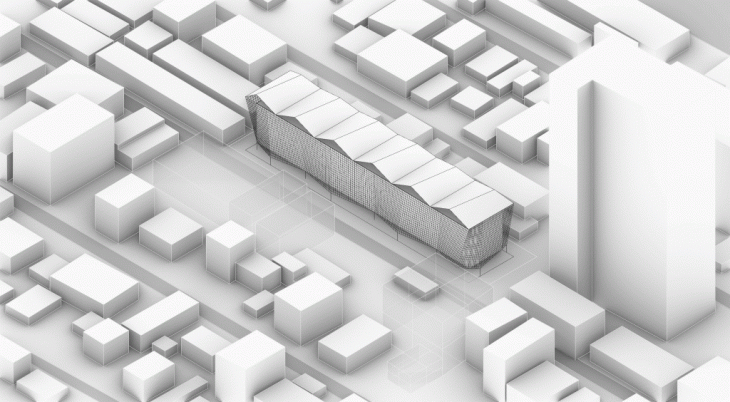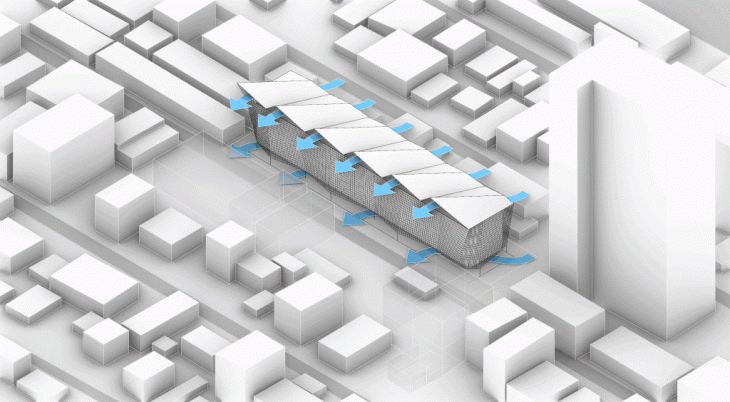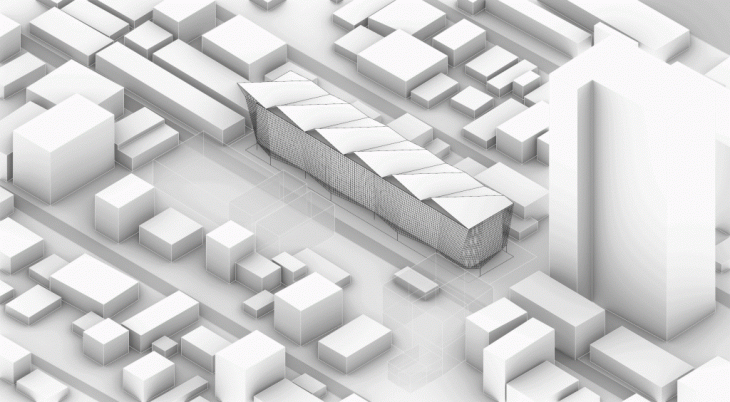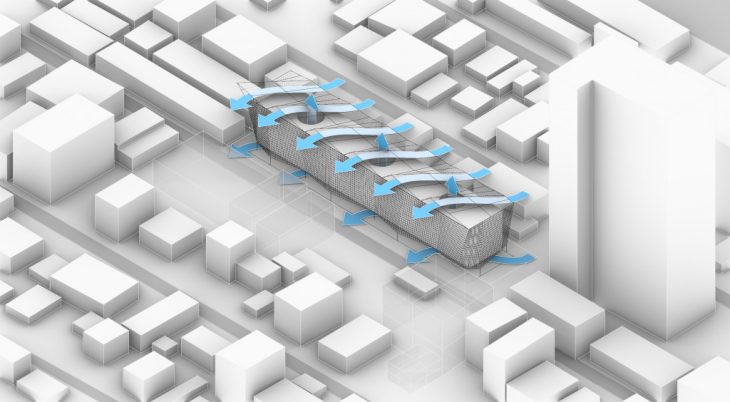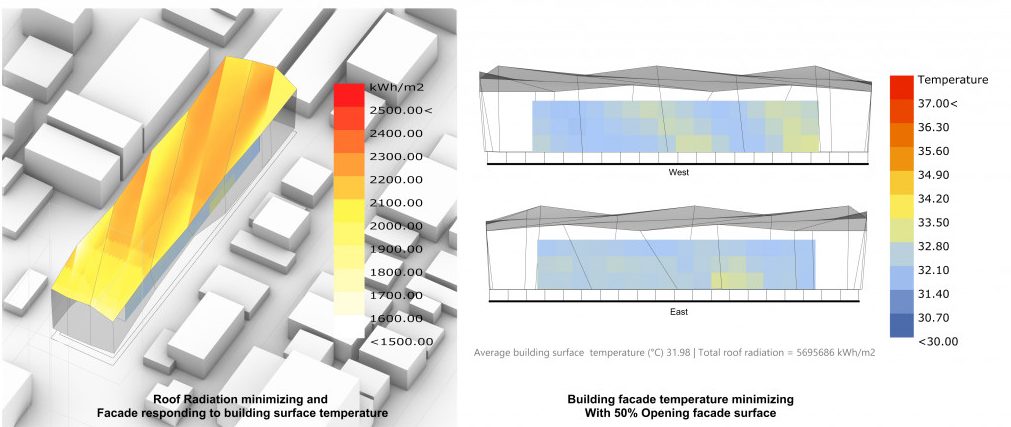Bangkok Residential Project : A Contemporary of Passive Cooling
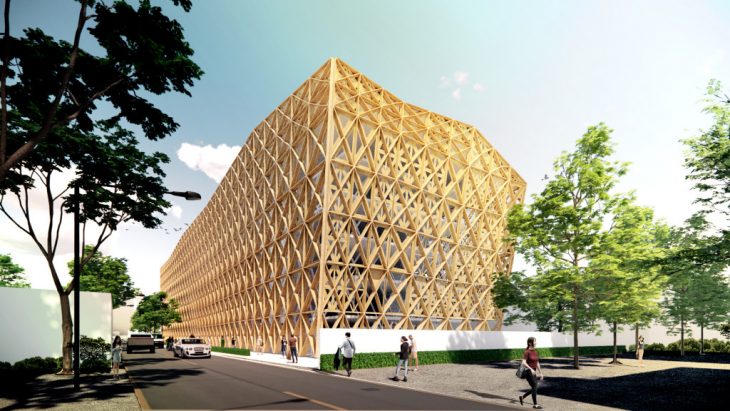
Project Description:
Bangkok is one of the most dense cities in the world with high temperature and humidity according to the tropical climate. Almost 30 percent of the housing energy consumption cost from air conditioning. In order to reduce household cost and carbon emissions, the design of our project, Bangkok residential building, proposes to use a passive cooling system as a main strategy with Carbon neutral based materials. From research of Bangkok climatic issues, we have extracted the principals of Thai vernacular architecture as the design involves a passive cooling system, and adapt to our project strategies such as incline roof for heat circulation, ground floor openings for cross ventilation and avoid flooding problems. To reduce heat temperature of interior space, Bangkok Residential Building is proposed with the Box-in-Box concept that includes interior façade and exterior shell. Where the zone between two facades is used as a buffer area to cool down the air before entering to the building. The project consists of 2 strategies of design related to the environmental data including forming optimization based on solar radiation and comfort temperature, second is the façade openings based on wind pressure analysis, solar radiation optimization, and daylight factor for efficient indoor visibility.
In conclusion, The design of project strategies has reduced 3.3 Degree Celsius according to the simulation results. And the façade openings could provide wind ventilation to create cross ventilation from South East to North West. And also, we have achieved to use Timber as a main structural materials which our goals are to create sustainability in terms of Carbon-neutral construction.
Local Climate : Located in a tropical climate zone and classified as a mostly humid zone. Bangkok has high temperature and humidity variation between seasons with 3 out of 4 quarters are moderate heat stress with more than 32 Degree Celsius recorded, and feel like temperature are 37 Degree Celsius.
Background : The BRB – Bangkok Residential Building consists of 2 strategies of design including form optimization based on solar radiation and comfort temperature, second is the façade openings based on wind pressure analysis with mainly focusing on passive cooling strategies extracted from Thai vernacular based architecture.
Building Data:
Height : 23 m
Stories : 5
Building Function : Residential
Structural Materials : Hybrid Concrete-Timber
Location : Bangkok, Thailand
Geographic position : Latitude 13.765350, Longitude 100.546514
Elevation : +3.5 above ground level
Climate Classification : Tropical, Hot and Humid
Mean Annual Temperature : 32.5 Celsius
Highest Temperature : 37.5 Celsius
Average Dry Bulb of the hottest months (April, May, June) : 35.3 Celsius
Percentage of Comfort time over the year : 13%
Average monthly precipitation : 148 millimeters
00_Site and Location
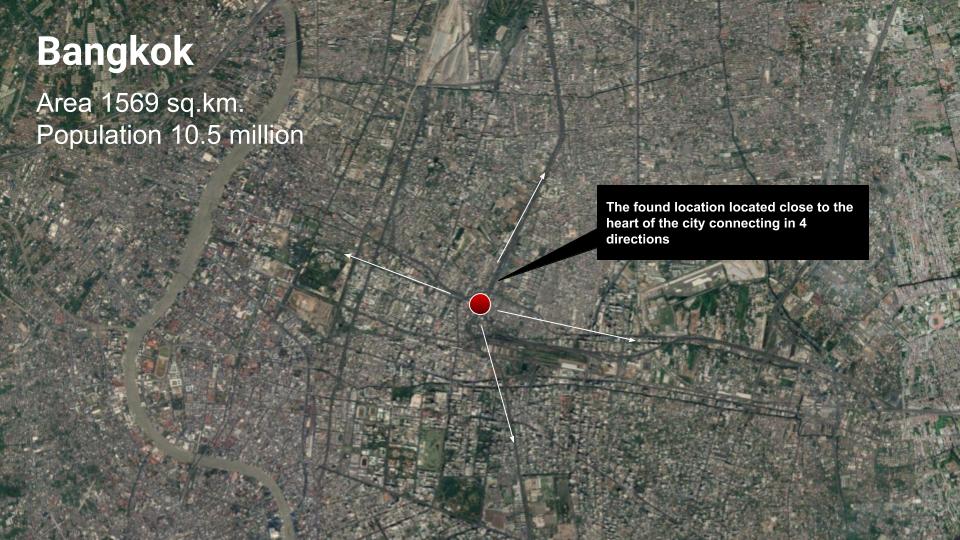
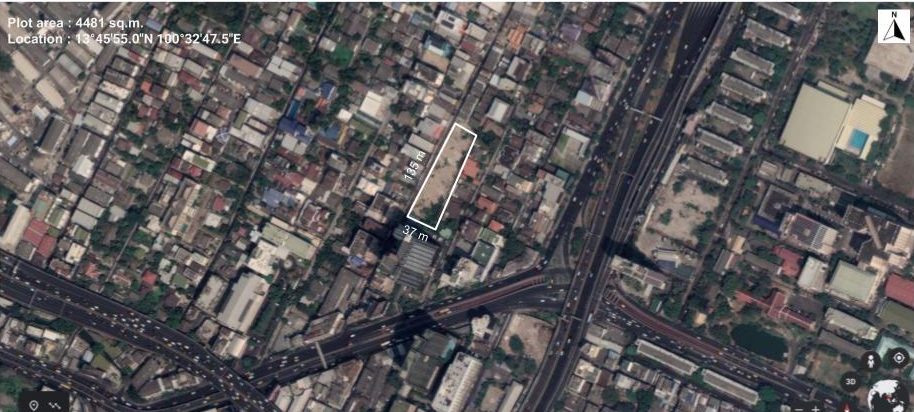
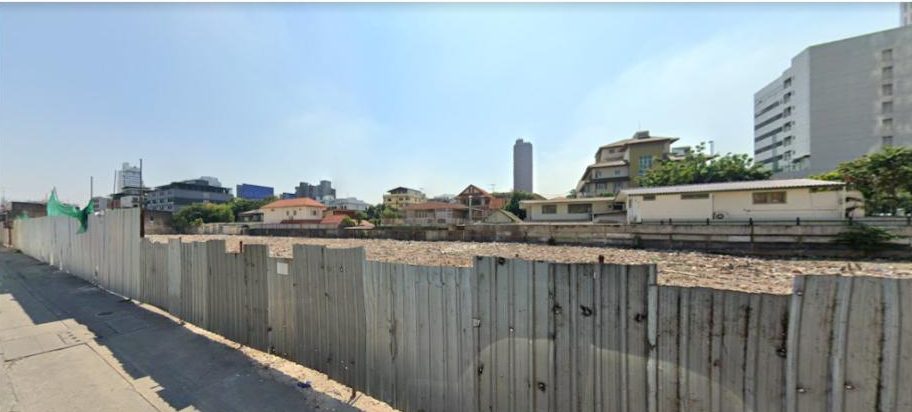
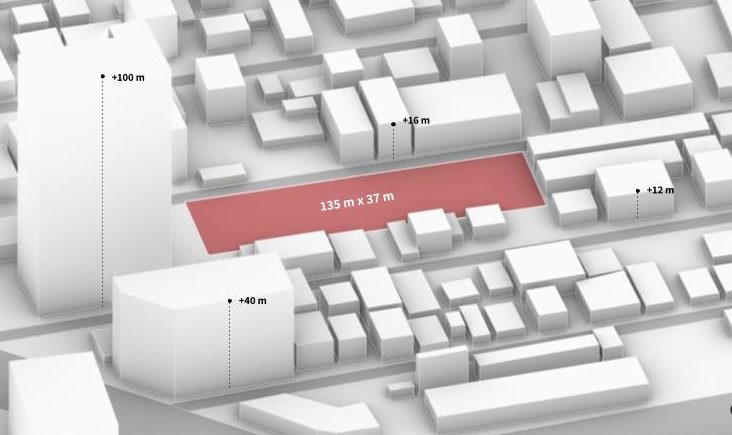
Observation and Analyze context data
The site location chosen to be near the center of Bangkok, the plot is surrounded by residential building and low-rise housing, and also empty and large enough to propose a large scale of residential program building. With a dimension of 135 m by 37 m, this dimension will be taken and linked to climatic issue later. That the long horizontal area will be our consideration in further process in a method of creating cross ventilation.
01_Climatic data and Analysis
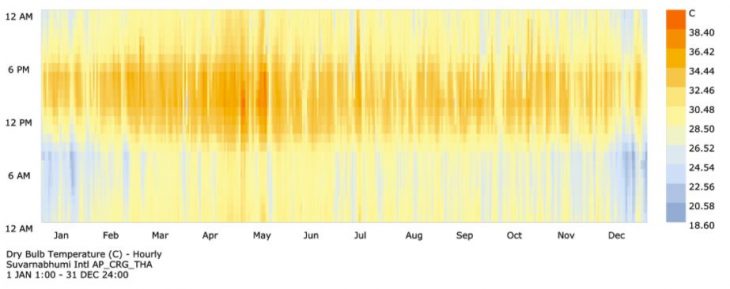
Temperature
According to the climatic data research from Ladybug using EPW data from Suvarnabhumi Intl’ Airport, showing the maximum average Dry Bulb Temperature appears in between April and May while the minimum average is in January and December. During the afternoon from 12PM to 6PM, the temperature constantly stay around 32 to 36 degree Celsius. Then decreasingly reach to 30 degree during the night and morning time.
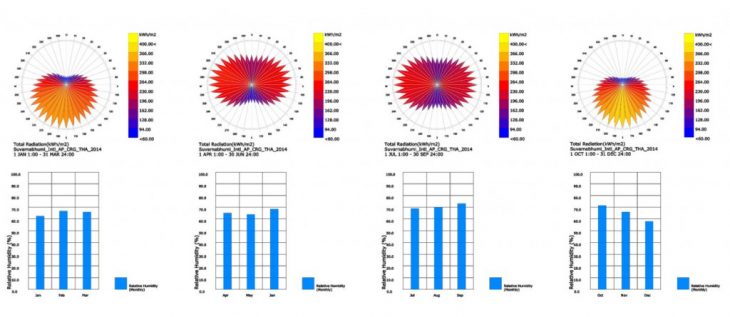
Radiation analysis and relation to climate
During Quarter2 & Quarter3 it appears that the Solar radiation has a range from below 94 to 300 kWh/m2. While winter time, Quearter1 & Quearter4, the solar radiation reach the higher values. During Quarter2 & Quarter3, They are rainy season and higher in relative humidity which diffuse direct solar radiation. And during Quearter1 & Quarter4, the sky is clearer which allow direct radiation to be higher.
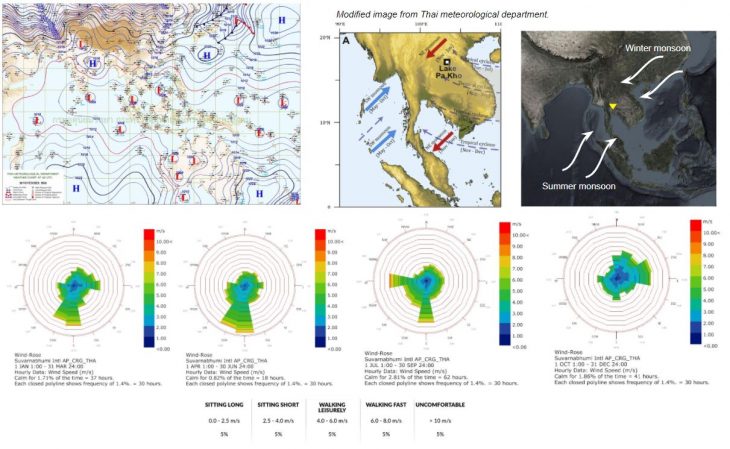
Wind Direction and relation to Season and humidity
According to Thai meteorological department and Ladybug data, showing that during Summer, the wind direction flow mostly from South and West(Oceanic). While in Winter, Oct – Dec, the wind mostly flow from the North (China and Vietnam). As the wind cannot flow directly from the North due to mountain side that geographically located along the border. The wind that come from the South mostly has a warm temperature and it also brought humidity from the ocean. The wind that come from the North is has the colder temperature which help reduce heat.
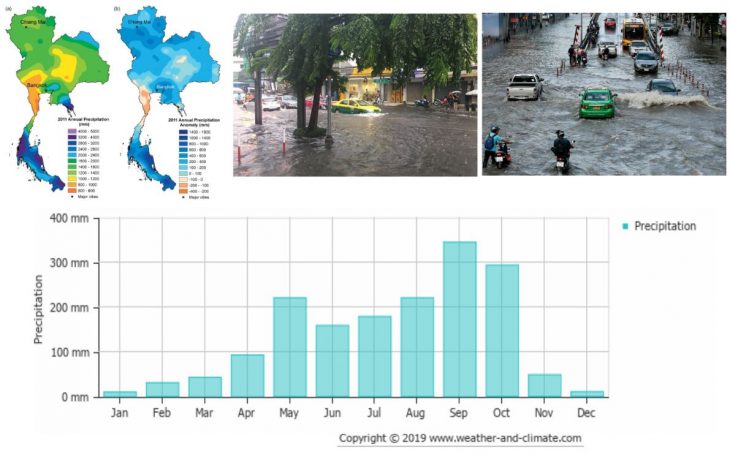
Rain precipitation analysis and environmental issues
Bangkok pulls on average 1498 mm of rainfall per year, or 124.8 mm per month. The wettest weather is in September when an average of 344 mm (13.5 in) of rainfall (precipitation) occurs. The driest month (with the lowest rainfall) is December (6.3mm). Also, Bangkok commonly has a flooding issue that happens seasonally due to poor drainage system which annually happens during September to October.
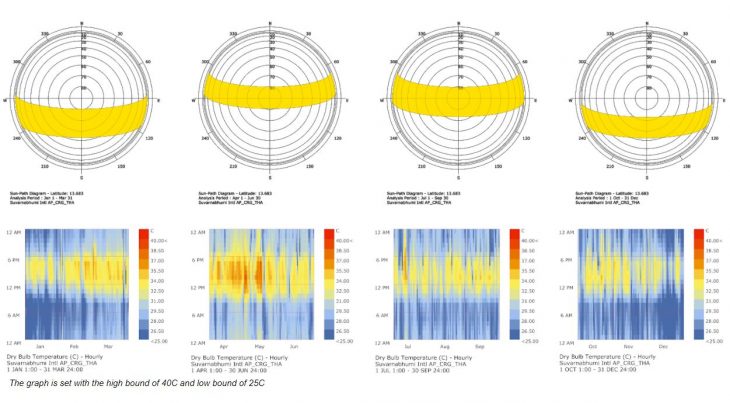
Temperature & Sun path relation
Sun path- The sun most reach the northern point during Summer(Apr – Sep) and start rising around the southern direction during Winter. (Oct – Mar)
Temperature – The highest temperature reach maximum(red) most in Apr-May and constantly stay averagely 34-35 Degree Celsius
The relation between sun path and temperature graph shows that when the sun rise perpendicularly in Summer, the temperature increase closely to highest point, and decrease to average temperature of 34-35 degree Celsius through the rest.


Comfort Condition
Data analyzed by Ladybug shows the comfort condition in Bangkok with the range starting from 0 up to +3. With majorly +2 as known as Moderate Heat stress has the most percentage of overall comfort condition with 55.6%. Unlike Europe, Bangkok is in the tropical country that people normally avoid facing directly to the sunlight. As it could easily burn the human skin within an hour. So by living under the shading area would be best condition This issue will be developed for our further design principles.
02_Manifesto
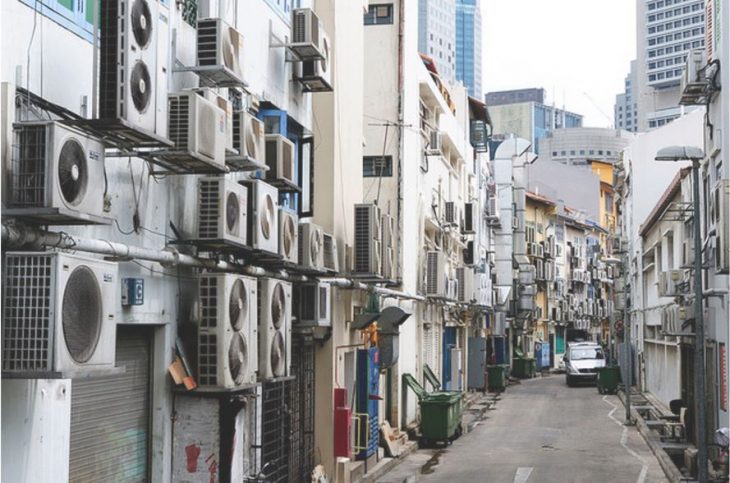
Bangkok is one of the most dense cities in the world with high temperature and humidity. Almost 30 percentage of the housing energy consumption cost from air condition operation. In order to reduce the household cost and carbon emission, we are proposing to design a passive cooling system with carbon-neutral based materials. The local Thai vernacular architecture will play a special role in the design as principals for passive design strategy.
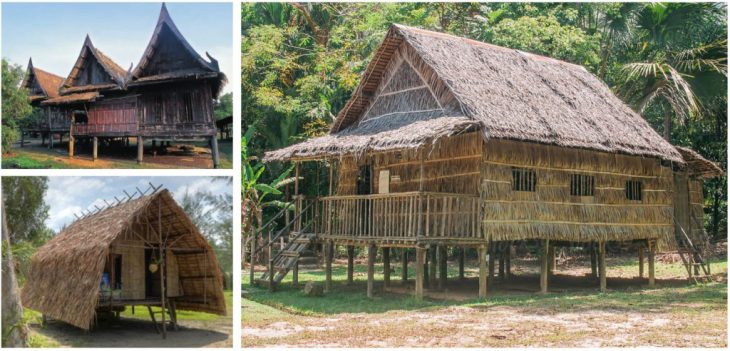
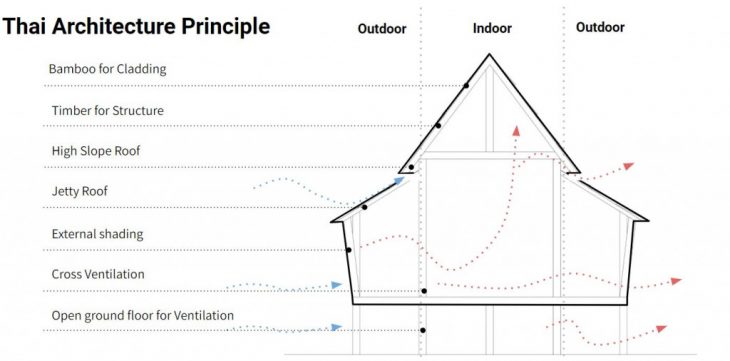
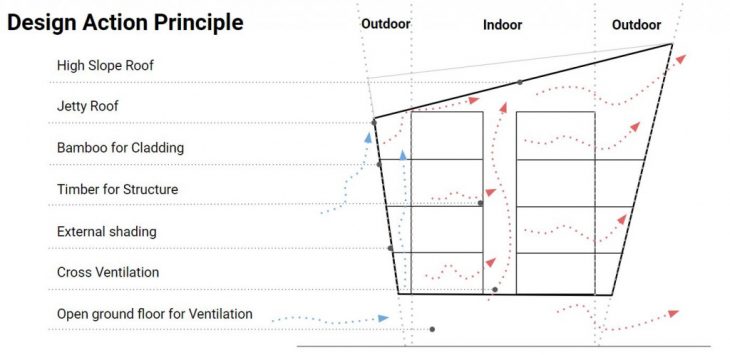
Project Strategy relation and reinterpretation to Thai Vernacular architecture
In relation to Thai vernacular architecture, as a role model for passive cooling, the elements of the project will be optimized according to the principle extracted from this system including open ground floor, high slope roof, self-shading, and most importantly Carbon-neutral based materials will be implement for the structure in order to raise the topic of Carbon emission issues.
03_Optimization and Modeling Strategy
- 1. Setback 6 m for Building regulation
- 2. Exceed height limitation at 24 m
- 3. Inset 3 m to create Box-in-Box concept as the space in between acts as a buffer for cooling air
- 4. Setback the ground façade to avoid direct sunlight and create self shading, and also, minimizing solar radiation and interior temperature
- 5. Open ground floor. Uplifting the building to have cross ventilation and let the wind flow for further step.
- 6. Create atriums for vertical ventilation. 3 atriums will be functioned as habitant circulations. Also they will be integrated with columns to support slab loading.
- 7. Create roof slope. With slope, roof can have an access for the wind to ventilate hot air out to the other side.
- 8. Roof rotated according to wind direction. By align the roof direction to wind direction, allowing faster flow to let heat from atrium out of the building
- 9. Optimal design
- 10. Building ventilation Diagram shows cross ventilation from East to West
Data Optimization
To reduce temperature based on our design principles, the strategy is a combination of roof solar radiation and façade forming to reduce inner box temperature and solar radiation at the same time. In this case, the algorithm could achieve the optimal solution with lowest temperature of inner box surfaces.

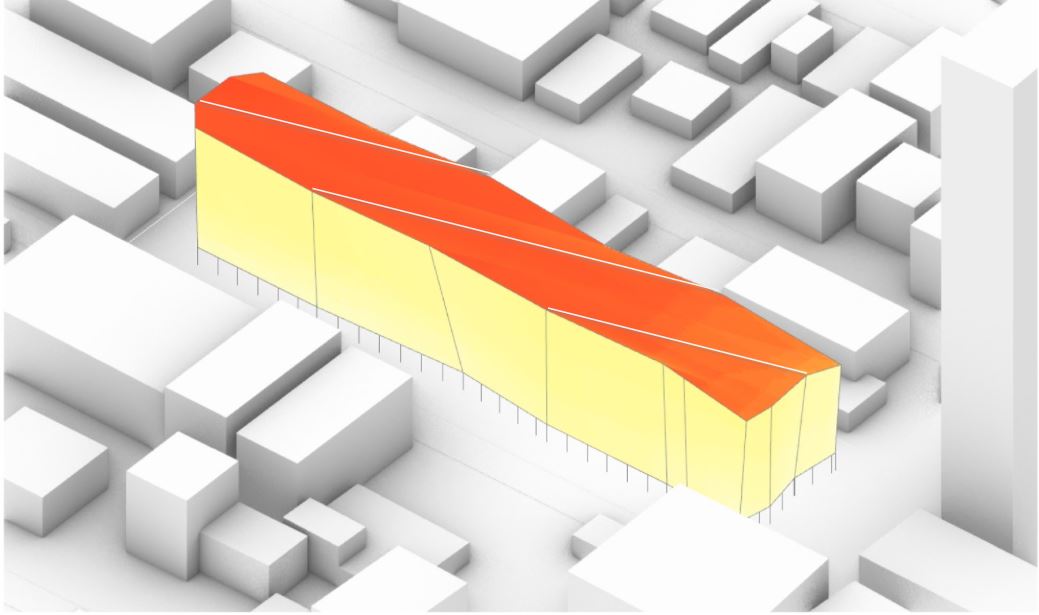 We found out that the average temperature is around 32.07 Degree Celsius, With the best rank we found has the inner temperature at 31.97 Degree Celsius. In this optimizing process, we could achieve to reduce the building temperature from 35.7 Degree Celsius down to 31.97 Degree Celsius, which we are expected that in long term could help decrease cost of Air conditioning.
We found out that the average temperature is around 32.07 Degree Celsius, With the best rank we found has the inner temperature at 31.97 Degree Celsius. In this optimizing process, we could achieve to reduce the building temperature from 35.7 Degree Celsius down to 31.97 Degree Celsius, which we are expected that in long term could help decrease cost of Air conditioning.
04_Further Development : Cross Ventilation
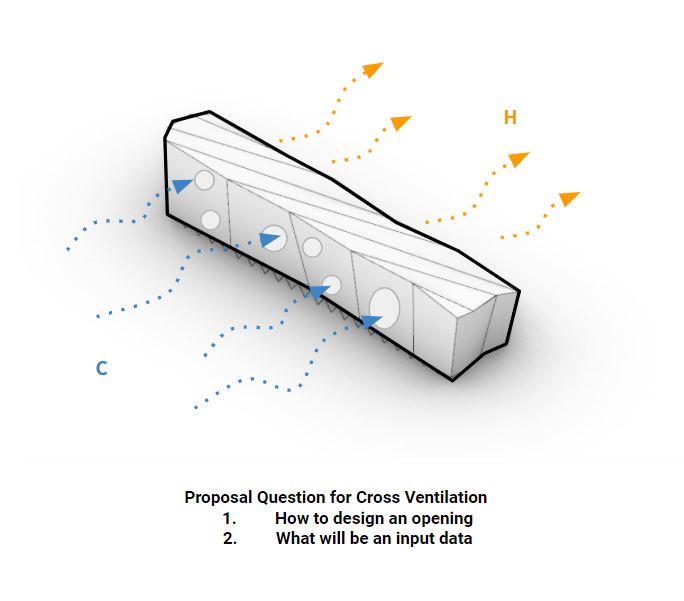
Proposal for Cross Ventilation
Since we have achieve the optimal form. The project still require the cross ventilation strategy. In this case, the façade will play an important role for opening in order to let wind flows across the building.
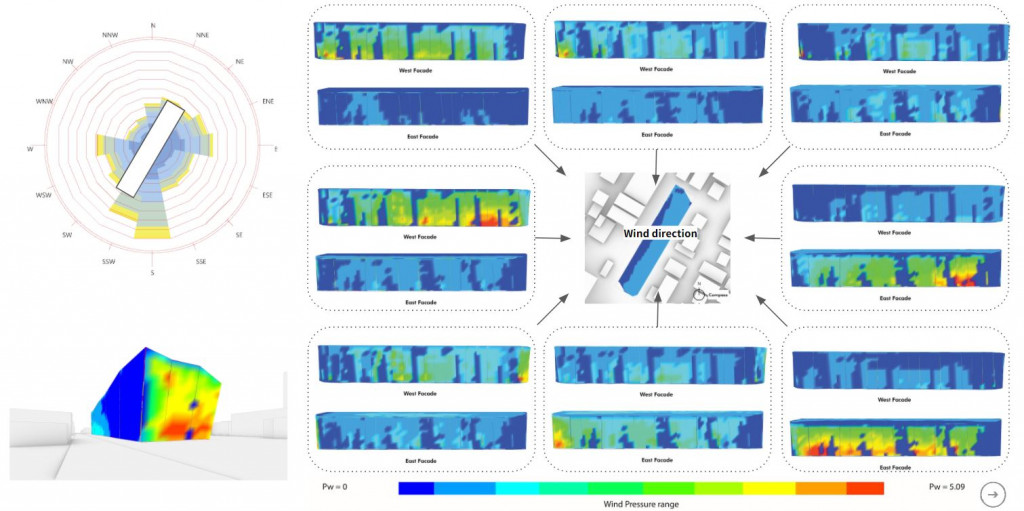
Wind Pressure Simulation
In this stage, the wind pressure will be the input for the openings. According to the windrose diagram, wind direction majorly came from the South side. Which in this case, it would effect to the East façade that will be our focused area and also the west façade as a final destination of the wind before exiting the building.
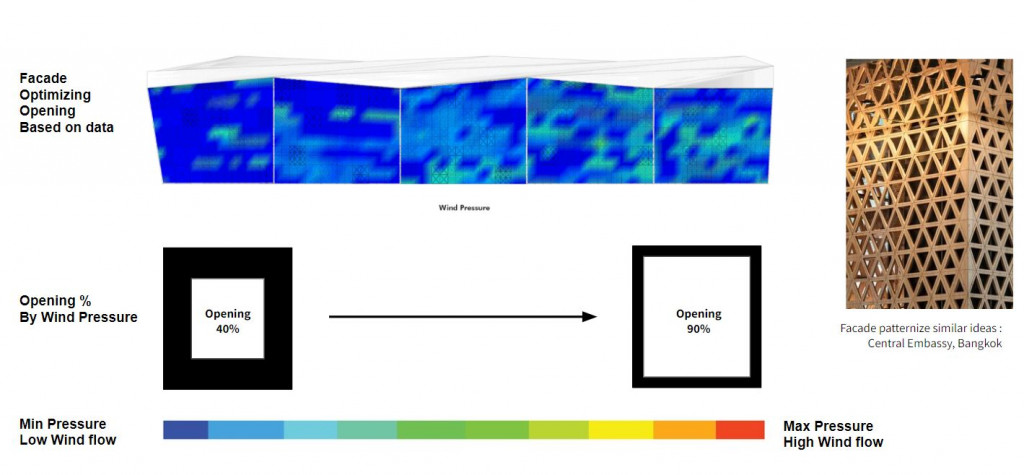
Strategy for openings
To use the data, By overlaying the wind pressure of 8 different direction and implement the pattern openings according to the pressure values happening on the façade (where Max pressure (red) are the most opening area and decreasing to minimum opening area on the low wind pressure) it allows us to know the location and define sizes according to the data.

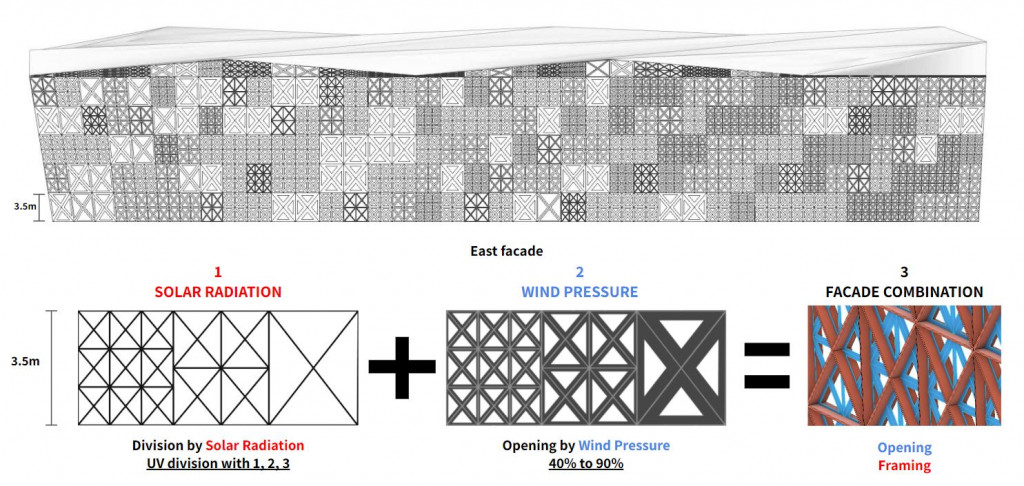
The 2 environmental data were compiled in order to optimize not only the cross ventilation but also consider more on optimal solar radiation. For solar radiation the data will be related to the division of the façade, while the wind pressure will define the opening sizes with in a diagonal grid division.
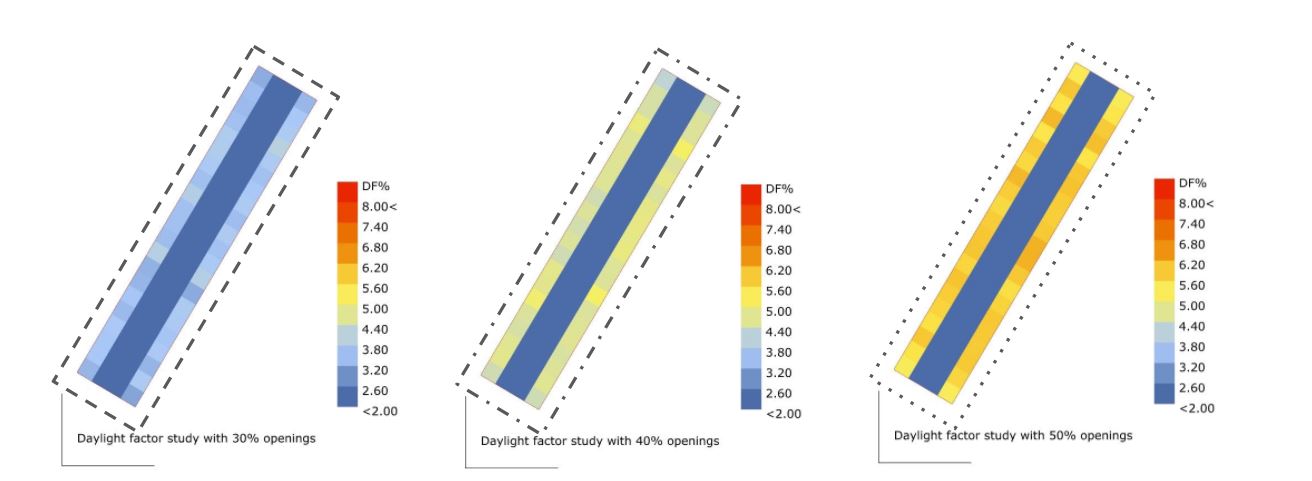
Daylight Analysis
In addition, not only focusing on reduction of Air condition used in terms of temperature, the minimum opening is also required to create effective and efficiency to lighting issue. Comparing with 3 different openings, we found that the optimal percentage suite is 40% which allow the inner box to have Daylight Factor around 5 that during the day, that allow the interior living space enough light which the inhabitants have no need to use artificial electricity for lights.
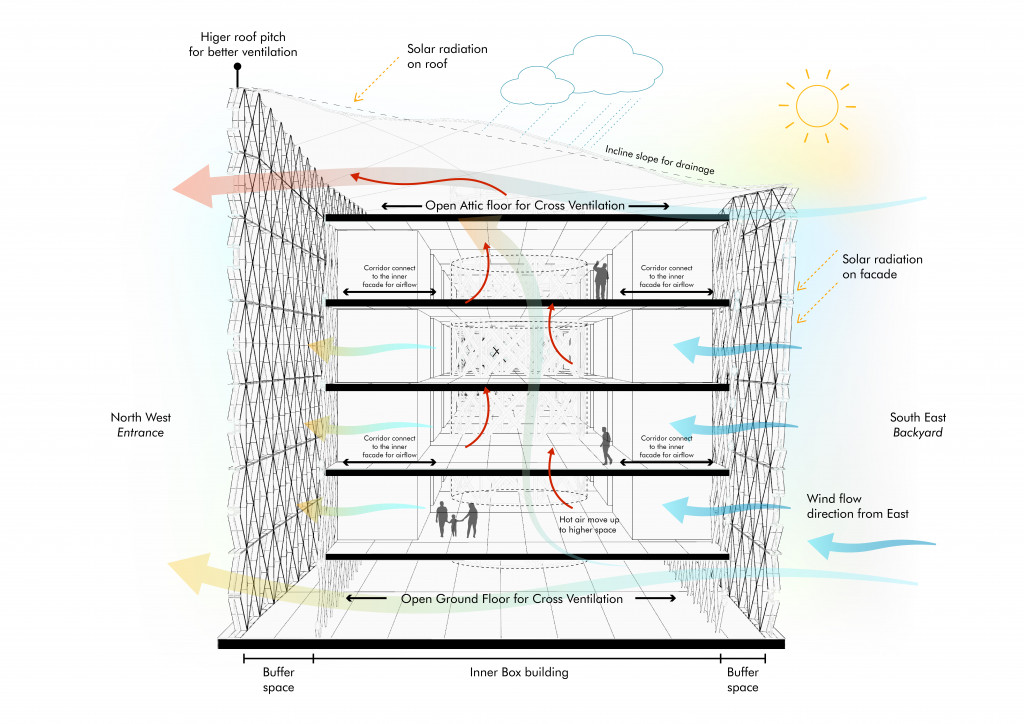
Section diagram : Cross Ventilation
The section diagram show the cross ventilation from South East to North West where the indoor hot air can flow up to the roof through the porosity of atrium structure before moving out of the building. Meanwhile, the inner façade will have the opening connecting to the corridor in order to circulate not only winds but flows of people for each floor.
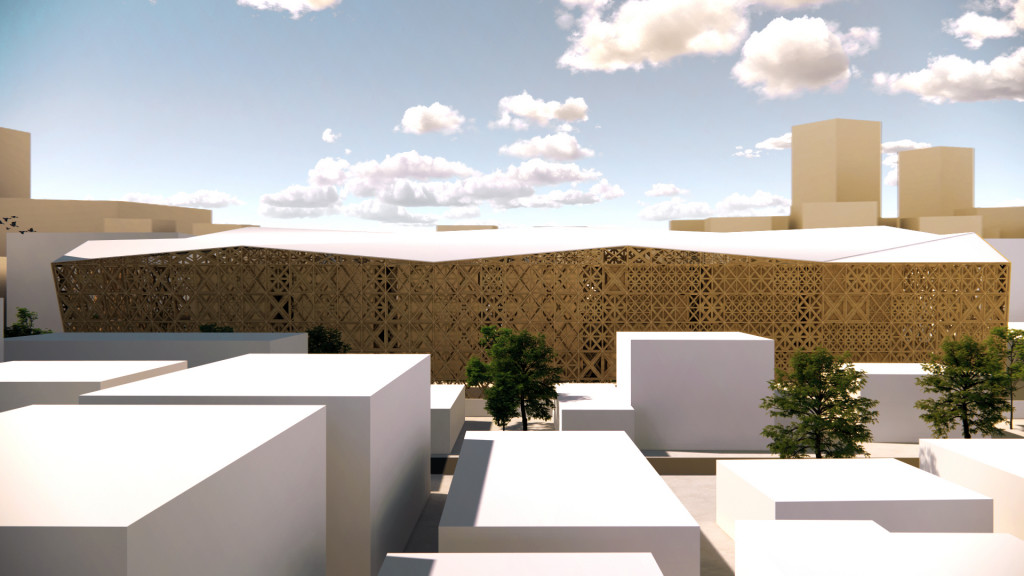
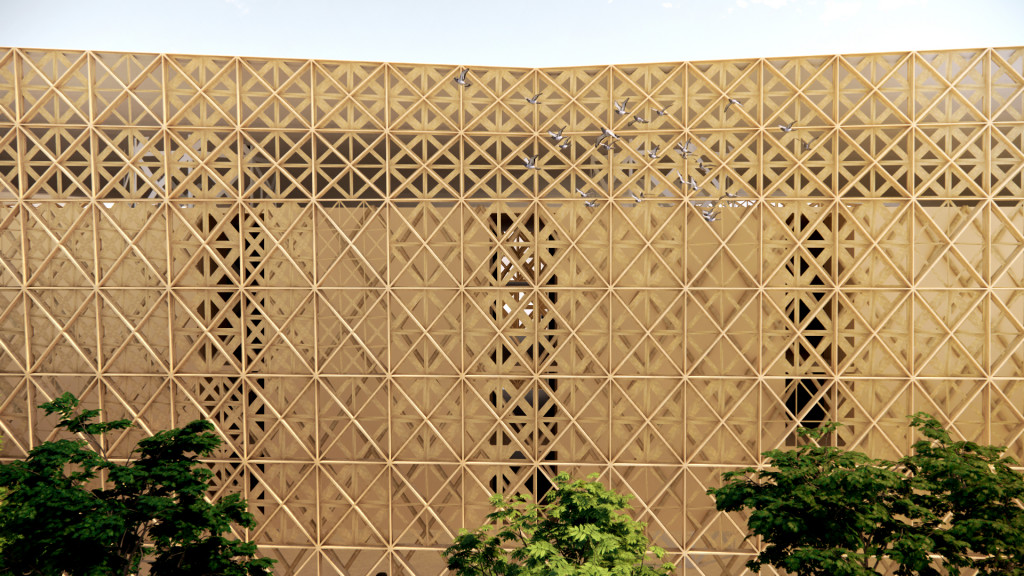
05_Program and Post Analysis



Wind speed to Comfort to Program
From this strategy, we have finally found the location of the most comfortable space according to the Lawson criteria. This area can use for developing spatial arrangement in further design by using the wind velocity behavior to define the programs within a space. We believe this data will help improve our design in term of programs and circulation in future process.
06_Conclusion
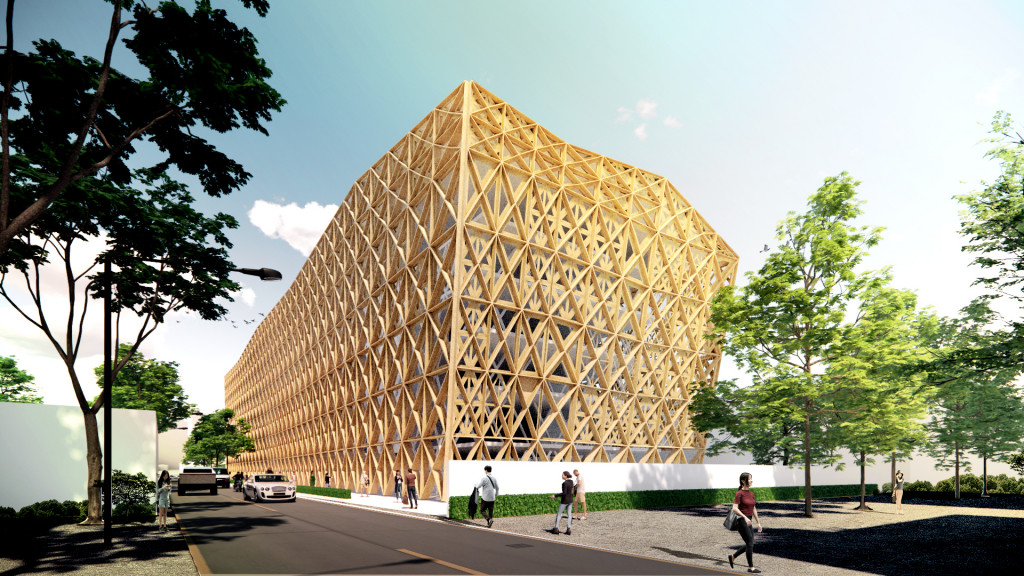
Conclusion of building operation to Environmental data:
- According to the optimization this optimized form can reduce building surface temperature from 35.27 to 31.97 Celsius = 3.3 Degree Celsius.
- Façade create not only openings for ventilation but also self shading for reduce direct solar radiation and provide enough daylight factor.
- Materials from 1F to 5F are all replaced with Carbon-neutral based.
Related project:
Bangkok Residential Building and Adaptive of Passive Cooling in Computational Architecture
